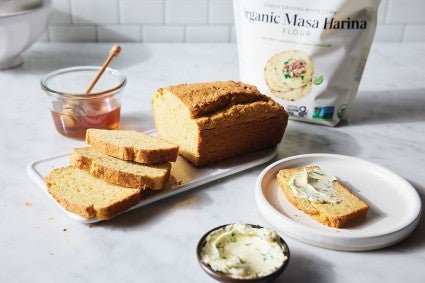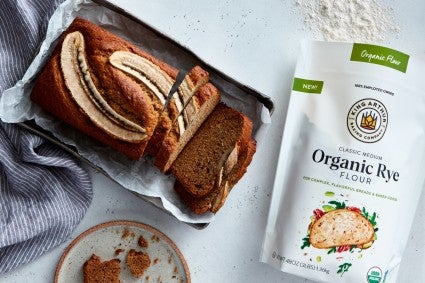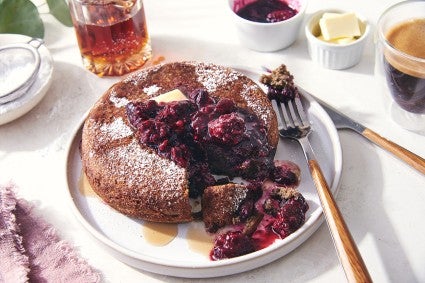To bake more sustainably, start using more of these flours
From rye to buckwheat, flour can be a planet-friendly choice in the kitchen.


So often, talking about sustainability in the kitchen means talking about all the things you should be eating or using less of: less meat, less dairy, less plastic. But what about ingredients you should be using more of, things that aren’t just less harmful options, but are actually improving the condition of the planet? Sustainably grown flours are one choice you can make that supports a better agriculture system, one that’s suited to a changing climate.
And it doesn’t have to be all or nothing: You can start swapping in the flours below for a portion of the flour in many of your favorite recipes. A good rule of thumb is to substitute alternate flours for 25% of the flour by weight in a recipe. And you won’t just be adding a dash of sustainability; in many cases, you can boost the flavor of your bakes and add in whole grains as well.
Here are the planet-friendly flours we recommend reaching for:

As Martin Philip explains in his blog post, Organic flour is about more than baking. It’s the future of farming, organic wheat improves the soil and the broader farm ecosystem. By decreasing the use of chemical inputs, farmers are supporting soil health, restoring natural ecosystems, and creating better growing conditions for future generations — and because they can sell organic wheat at a premium, organic farming is financially sustainable for the farmers, too. Supporting the work of these steadfast farmers helps support a more sustainable food-growing system, one loaf of bread at a time. (Simply swap organic flour 1:1 in any recipe calling for the same type of flour.)
King Arthur has a wide range of organic flours, including organic all-purpose flour, organic bread flour, organic whole wheat flour, and even organic masa harina, which is made from American grown and milled white corn.
Start baking: Organic Whole Grain Banana Bread, Organic Peanut Butter Chocolate Buttons, Organic No-Knead Pizza Crust

Here’s what you need to know about rye: It’s a sustainability superstar. In agriculture, rye has the almost magical capacity to improve soil health. (And bonus: Our rye flour — both medium rye and pumpernickel — is also organic!) “It’s considered the hardiest of all the cereal crops,” says Laura Valli, a doctorate student studying rye at the Washington State University’s Breadlab. “It has weed-suppressing properties, so there’s less of a need to use herbicides. It also has an expansive root system, which is why it’s so good at water uptake; it can grow well in dry soils and help prevent erosion.”
Laura emphasizes that consumers can do their part to make agriculture systems more sustainable by baking with more rye flour. She explains that the onus is on consumers to show they’re interested in and willing to consume rye. By demonstrating demand, farmers — many of whom want to grow rye but are worried about there being a viable market for the grain — might be convinced to plant more.
And it’s not a chore to bake with rye, either. Rye flour unlocks a whole new world of flavor and texture in baked goods. Its earthy, nutty taste is a perfect complement to rich, cozy flavors like browned butter, caramel, and chocolate. Meanwhile, its lower gluten content promotes tenderness in baked goods like cookies, cake, and pastry. Rye also offers better moisture retention, leading to baked goods that are moist and soft.
Start baking: Rye Chocolate Coffee Cake, Rye Chocolate Chip Cookies, Classic Rye Sandwich Bread

One standout characteristic of buckwheat is that it grows quickly in poor soil (maturing to harvest in 90 days, as opposed to wheat’s 200 days). As Klaas Martens, a third-generation farmer in Penn Yan, New York, is quoted in Martin Philip’s article on buckwheat sustainability, “You can throw it in dust and it’ll sprout.” It does more than just grow in tough conditions: Buckwheat can also “unlock” phosphorous in the soil, freeing it for other crops (like wheat, which needs a lot of phosphorous) to make it available without the need for chemical fertilizers.
As Martin writes, current estimates project that the world’s remaining supplies of phosphorus will last just 20 years given the current rate of agricultural use. Conventional farming, with significant reliance on the chemical application of phosphorus, will need to find a different model to feed our growing planet. A crop like buckwheat, which frees phosphorous in the soil, can be part of the solution.
With its distinct flavor and texture (it’s also gluten-free, despite its misleading name!), buckwheat can make an exciting addition to your baking. It has a lovely grassy flavor with notes of rose and a slight bitterness that makes it well-suited to baked goods both savory and sweet. On the sweet side, buckwheat goes nicely with baked fruits, nuts, and caramel; when it comes to savory pairings, buckwheat is a good companion for rich, salty ingredients like cheese, cured meats, capers, sour cream, and more.
Start baking: Baked Buckwheat Pancake with Berry Compote, Buckwheat-Cardamom Chocolate Chunk Cookies, Zingerman’s Honey Cake, Blini

If you’ve typically shied away from whole wheat because you fear a dense and bitter baked good, give Golden Whole Wheat Flour a shot. Because it’s milled from hard white wheat, it’s lighter in color and milder in flavor than regular whole wheat flour while still retaining all of the fiber and nutrients of the whole grain.
But what truly sets it apart is how that wheat was grown. All of the wheat used in our Golden Whole Wheat Flour is grown using regenerative agriculture practices. Regenerative agriculture seeks to restore, renew, and enhance natural resources through a range of practices that focus on healthy soils, ecosystems, and farming communities. It’s not just about sustaining our planet, but actively healing it. Learn more here: What is regenerative agriculture, and why is it so important?
Start baking: Easy Granola Bread, Lachha Paratha, Fudgy Chocolate Date Cake
Find our full line of organic flours and other options available in our Shop. Let us know what you’ll be baking in the comments, below!
Cover photo and food styling by Liz Neily.


